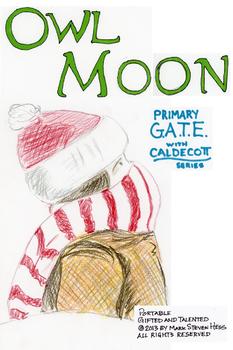Primary GATE with Caldecott -- Owl Moon Pop-up and Critical Thinking
Portable Gifted and Talented
3.1k Followers
Grade Levels
K - 3rd, Homeschool
Subjects
Standards
CCSSRL.1.7
CCSSRL.2.7
CCSSSL.2.1
CCSSSL.2.2
CCSSSL.2.3
Formats Included
- Word Document File
Pages
32 pages
Portable Gifted and Talented
3.1k Followers
Description
Now with a more kid-friendly pop-up option:
Owl Moon is incredibly rich in critical thinking potential, rich in artwork, and rich in the feelings words evoke.
Come along for a challenging lesson and a fun extension activity with the poetic 1988 Caldecott Award winner Owl Moon. Critical thinking about poetry, participatory reading, and figurative language along with a project in which we create an owl to “pop up” and spread its wings poetically will energize your students.
Caldecott books are perfect for our highly visual 21st Century Learners. I use this lesson with my 1st grade advanced readers at the end of the school year. 2nd and 3rd graders should be right on target as well. Got a gifted kindergarten group? This will be an especially tough challenge for them but promises to stretch kids’ imaginations and critical thinking skills across 4+ grade levels. I also use Caldecott books with whole class 4-5th grade classrooms (with some modifications) when teachers have asked me to come to their classes to provide a full class extension. The picture book format makes it easier for us to springboard from content to critical thinking—and the 4-5th graders still love picture books.
With this lesson, you’ll get critical thinking questions to guide your students, ready-to-print activity sheets which delve into the language of poetry, and templates with a complete guide to completing the pop-up.
Owl Moon is incredibly rich in critical thinking potential, rich in artwork, and rich in the feelings words evoke.
Come along for a challenging lesson and a fun extension activity with the poetic 1988 Caldecott Award winner Owl Moon. Critical thinking about poetry, participatory reading, and figurative language along with a project in which we create an owl to “pop up” and spread its wings poetically will energize your students.
Caldecott books are perfect for our highly visual 21st Century Learners. I use this lesson with my 1st grade advanced readers at the end of the school year. 2nd and 3rd graders should be right on target as well. Got a gifted kindergarten group? This will be an especially tough challenge for them but promises to stretch kids’ imaginations and critical thinking skills across 4+ grade levels. I also use Caldecott books with whole class 4-5th grade classrooms (with some modifications) when teachers have asked me to come to their classes to provide a full class extension. The picture book format makes it easier for us to springboard from content to critical thinking—and the 4-5th graders still love picture books.
With this lesson, you’ll get critical thinking questions to guide your students, ready-to-print activity sheets which delve into the language of poetry, and templates with a complete guide to completing the pop-up.
Total Pages
32 pages
Answer Key
Included
Teaching Duration
Other
Report this resource to TPT
Reported resources will be reviewed by our team. Report this resource to let us know if this resource violates TPT’s content guidelines.
Standards
to see state-specific standards (only available in the US).
CCSSRL.1.7
Use illustrations and details in a story to describe its characters, setting, or events.
CCSSRL.2.7
Use information gained from the illustrations and words in a print or digital text to demonstrate understanding of its characters, setting, or plot.
CCSSSL.2.1
Participate in collaborative conversations with diverse partners about grade 2 topics and texts with peers and adults in small and larger groups.
CCSSSL.2.2
Recount or describe key ideas or details from a text read aloud or information presented orally or through other media.
CCSSSL.2.3
Ask and answer questions about what a speaker says in order to clarify comprehension, gather additional information, or deepen understanding of a topic or issue.


